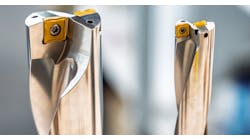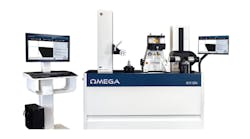The NC4 laser tool checkers were installed on two Stama vertical machining centers that are dedicated to machining of critical camshafts.
The Renishaw system uses noncontact laser technology to provide detection against tool breakage that can damage the valuable cams. Desmodromic valves, standard on all Ducati twocylinder motorcycles since 1972, have a unique camshaft design with special lobes that provide positive mechanical actuation to open and close intake and exhaust valves.
A high level of precision is required in machining the complex and costly camshafts, according to Fulvio Abbondi, manufacturing technology specialist at Ducati’s Bologna, Italy factory.
Forged from a special steel alloy, then hardened and tempered, a camshaft already represents a significant investment as a roughturned blank when it reaches a machining center, Abbondi noted. The Stama vertical machinining centers are configured for four-axis machining with a rotary fixture. Four cam workpieces are mounted on the fixture at a time for batch processing.
Between the toughness of the cam steel and volume-production requirements, there is constant risk of a chipped or broken tool being picked up from the magazine, and that can lead to serious damage and costs. A broken tool that goes undetected can force the scrapping of the expensive components or costly re-machining, along with wasted time. A broken tool also can damage the machine tool spindle, and run up costs for repairs and lost production
Ducati tries to keep the cam machining centers working non-stop producing camshafts for all of its different engines.
“It is essential that control checks be carried out on the work performed by the machines,” Abbondi said. “The NC4 systems are installed so that a tool loaded in the spindle immediately crosses the laser beam at a set height. If the cutting tip is broken, for example 97 mm long instead of 100 mm, the laser system triggers an alarm. Each tool has its own length, diameter and other characteristics that the system takes into account when the tool passes through the checking beam.”
The noncontact system is particularly effective at checking the small tools used to make keys and other reference points on the cam. Those features are vital for the engine’s operation.
“Small tools can be problematic with conventional contact detection systems,” Abbondi said. “The tool must activate a button or rod, so the touch must be done at low speed slowing down the process and lengthening cycle times. Contact systems tend to jam and present poor reliability. There also is the danger that the contact action can break or damage a small tool. Contact systems often must be fitted inside the operating area, occupying valuable space and causing possible collision risks. For all those reasons, the noncontact laser detection system was adopted to replace contact devices.”






